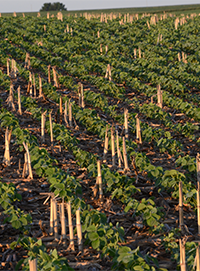 No-till soybeans can reap plenty of advantages, but they demand tighter management. Your success depends on healthy soils and efficient nitrogen recycling with these legumes, as well as managing weeds through careful selection of a no-till soybean herbicide platform.
No-till soybeans can reap plenty of advantages, but they demand tighter management. Your success depends on healthy soils and efficient nitrogen recycling with these legumes, as well as managing weeds through careful selection of a no-till soybean herbicide platform.
“You’re going to save money in fuel and equipment wear and tear by not having to run heavy tillage equipment over the field prior to planting,” says Bill Johnson, a weed science professor at Purdue University in West Lafayette, Ind.
“You're going to minimize the opportunity for compaction because you don't have to use that heavy equipment before planting. Certainly, from a standpoint of cost, compaction, and convenience, it's very desirable to be able to go into that field in the spring and plant without doing anything prior to that — other than maybe a burndown herbicide if you have some weeds that grew in the spring before you were able to get the crop in the ground.”
Crop breeders have developed soybean varieties that can handle some of the cooler soil conditions typically seen in no-till fields, Johnson notes.
“The soybean crop itself handles a no-till system very well,” says Mike Koenigs, market development specialist for Corteva Agriscience in Illinois. “Advantages of no till would be, obviously, less equipment, burning less diesel fuel, and less expense. There's going to be a lot of soil property advantages, including less potential for soil erosion with that system. Also, an advantage of not tilling the soil is your seed bank is right there at the soil surface. You’re putting your preemergent chemistry in the same spot, giving good control with residual chemistry in that zone.”
An advantage of not tilling the soil is your seed bank is right there at the soil surface. You’re putting your preemergent chemistry in the same spot, giving good control with residual chemistry in that zone.”
With soybean crops prone to erosion in parts of the Midwest and other spots in the U.S., going no-till enables rotation to foster soil health and stewardship, notes John Clefisch, a market development specialist for Corteva Agriscience in Iowa. “If you are no-tilling soybeans, you could rotate from corn to beans in an effective manner without having any type of soil erosion issues,” he says.
To be sure, there are disadvantages to manage. With no tillage passes, you can’t aerate compacted areas, or kill and bury weeds. And you may grapple with water-logged pockets.
Here are five tips to help you succeed with a no-till soybean herbicide program:
1. Know your weeds
“The number one tip is you have to know your enemy; you have to know what weeds you have in the field so you can pick the appropriate products to manage those weeds,” Johnson says. Plan your weed management now in case there are supply issues to deal with, he urges.
Experts advise scouting right from the combine during harvest to note problem areas as you plan a strategy for next spring.
2. Start clean with burndowns
With no tillage to eliminate the first flush of weeds, you’ll need a burndown. Many growers use a residual herbicide with that to control the next several flushes of weed that will germinate, Koenigs adds.
Most often, you have a greater weed pressure at the beginning of planting, making burndown critical. Koenigs stresses that if you're dealing with marestail, consider a burndown in the fall.
He and Clefisch say growers should consider a fall burndown, perhaps with Elevore® herbicide, then a spring-applied application of Sonic® herbicide and then follow that in-crop with Enlist One®, Abundit® Edge or Durango® DMA® and EverpreX® herbicides.
3. Plan and time your attack
Time your attack to ensure you're creating a program that will provide optimum weed control.
You need a strong at-plant residual herbicide. And once the beans are up, gear up for post-herbicide applications. They need to be timely, when weeds are no more than four to six inches tall.
4. Manage residue
“Sometimes, if you're not doing tillage, you can have a lot of residue buildup to manage,” Koenigs says.
“Also, sometimes early spring to early summer, you have cooler, wetter soils because of all that residue from the previous year's crop, and that can slow the establishment of the soybean crop. So that is something to also think about and manage.”
One approach is to have planter attachments that can push residue out of the way to clear a path for proper seed placement.
5. Get your canopy going
The more canopy you get, the less weed germination, which helps your beans remain dominant.
By creating a good burndown residual program pre-emergence with a good, layered residual and post-emergence program, Clefisch says, you're giving your no-till soybean crop its best chance to outcompete any weeds and keep them from germinating at all throughout the growing season.
This content produced by Farm Progress for Corteva Agriscience.
Abundit® Edge, Durango® DMA®, Elevore®, Enlist One®, EverpreX®, and Sonic® herbicides are not registered for sale or use in all states. Contact your state pesticide regulatory agency to determine if a product is registered for sale or use in your state. Enlist One herbicide is the only 2,4-D product authorized for use in Enlist crops. Consult the label before purchase or use for full details. Always read and follow label directions.
The More You Grow
Find expert insights on agronomics, crop protection, farm operations and more.